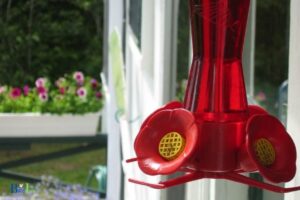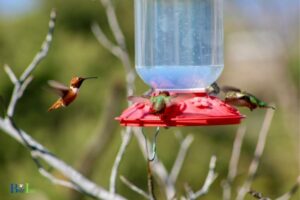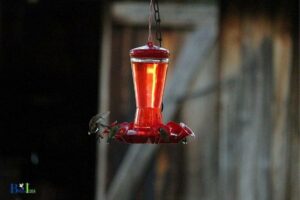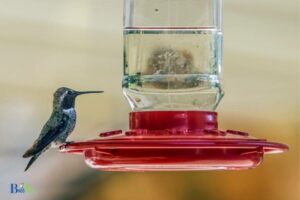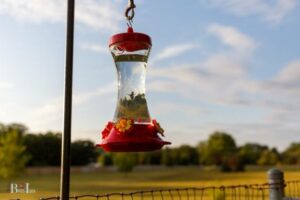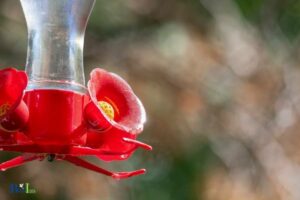How to Clean First Nature Hummingbird Feeder: Reassembling!
To clean a First Nature hummingbird feeder, you need to disassemble the feeder, soak the parts in a mild soap solution, scrub the parts with a soft brush, rinse thoroughly, and air dry before reassembling and refilling.
Regular cleaning of your First Nature hummingbird feeder is essential to maintain its attractiveness and ensure the health of the hummingbirds visiting your feeder.
Dirty feeders can develop mold and other harmful bacteria, which can make the birds sick. By cleaning your feeder at least once a week or more often if needed, you can provide a safe and healthy environment for the birds.
It’s important to clean your First Nature hummingbird feeder regularly and following these simple steps can make the process quick and efficient. If you notice any mold or debris buildup, be sure to clean the feeder more frequently.
To keep your hummingbird visitors happy and healthy, make a habit of checking the feeder’s condition and refilling it with fresh nectar every few days
11 Steps to Clean First Nature Hummingbird Feeder:
| Step | Instructions | Tools/Items Needed |
| 1 | Disassemble the feeder | N/A |
| 2 | Empty out any remaining nectar | Trash bin |
| 3 | Rinse all parts with warm water | Warm water |
| 4 | Fill a container with a solution of warm water and dish soap | Container, warm water, dish soap |
| 5 | Submerge the feeder parts in the soapy solution | N/A |
| 6 | Use a soft-bristle brush to clean the parts | Soft-bristle brush |
| 7 | Ensure the feeding ports and reservoir are thoroughly cleaned | N/A |
| 8 | Rinse all parts with warm water to remove soap residue | Warm water |
| 9 | Allow the feeder parts to air dry completely | N/A |
| 10 | Reassemble the feeder | N/A |
| 11 | Refill with fresh nectar and rehang | Fresh nectar, feeder hanger |
Key Takeaway
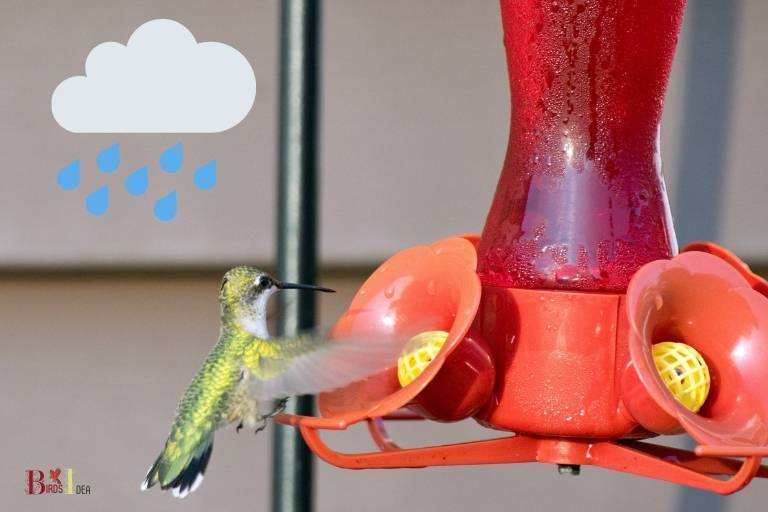
Five Facts About: Clean First Nature Hummingbird Feeder
Understanding The Importance Of Regular Cleaning
First nature hummingbird feeders are the perfect way to attract these beautiful creatures to your garden. While these feeders serve as a great source of food for the hummingbirds, they can also become breeding grounds for harmful bacteria and mold if not cleaned regularly.
Here is why regular cleaning of your first nature hummingbird feeder is crucial for the health and well-being of hummingbirds.
Why Regular Cleaning Of Your First Nature Hummingbird Feeder Is Crucial For The Health And Well-Being Of Hummingbirds
Regular cleaning of first nature hummingbird feeder is crucial to ensure that hummingbirds enjoy their food while staying healthy.
Here are some reasons why cleaning your feeder should be a regular chore on your to-do list:
- Prevent the growth of bacteria and mold: The leftover nectar in your hummingbird feeder can turn into a breeding ground for bacteria and mold. Regular cleaning can prevent this and ensure the nectar stays fresh.
- Keep the hummingbirds healthy: When hummingbirds drink from a dirty feeder, they may contract illnesses which can lead to sickness and even death. Regular cleaning helps keep your hummingbirds healthy.
- Ensure fresh nectar: The nectar in the feeder can also become stale over time. Cleaning the feeder regularly ensures that only fresh nectar is available for the hummingbirds.
- Extend the life of your feeder: Regular cleaning helps remove accumulated dirt and grime that could damage or affect the functionality of your hummingbird feeder.
Effect Of Dirty Feeders On The Feeding And Social Behavior Of Hummingbirds
Dirty feeders do not only pose a health risk to hummingbirds, but they can also affect their feeding and social behaviors.
Below are some effects of dirty feeders:
- Reduces the number of hummingbirds: Hummingbirds are social birds that share feeding grounds. Dirty feeders with stale nectar and mold may discourage them from feeding at your feeder altogether.
- Affects feeding behavior: When hummingbirds feed from dirty feeders, they may be deterred by the smell of the rancid nectar. This can lead to decreased feeding and nutrient intake.
- Decreases competition: A dirty feeder may attract fewer hummingbirds, leading to a decrease in competition for food. A decrease in competition results in more aggressive birds, which could disrupt peaceful feeding environments.
Signs Your Feeder Needs Cleaning
Now that you understand the importance of cleaning your first nature hummingbird feeder regularly, how do you know when it’s time to do so?
Here are some signs that your feeder needs cleaning:
- The nectar appears cloudy or has black spots: Cloudy nectar is a sign of bacterial or fungal growth, while black spots indicate mold.
- Presence of debris: If there are dead insects or debris in the nectar, it’s a sign that your feeder needs cleaning.
- Foul smell: When the nectar in the feeder starts developing an unpleasant smell, it’s time to clean it.
Cleaning your first nature hummingbird feeder regularly is crucial to maintain a healthy feeding environment for these beautiful birds. Make sure to follow the manufacturer’s instructions when cleaning the feeder.
It’s recommended that you clean the feeder at least once every three days during summer and once a week in the less humid months.
With a clean and fresh feeder, hummingbirds will keep coming back, and you can enjoy their beauty all season long.
Gathering Materials And Preparing For Cleaning
Keeping your hummingbird feeder clean is essential for the health and well-being of these tiny birds. A dirty feeder can result in the growth of harmful bacteria and fungi, which can cause illness or even death of the birds.
If you own a first nature hummingbird feeder and would like to learn how to clean it correctly, then follow this guide.
Recommended Cleaning Tools And Materials For Effective Cleaning
Gathering all the necessary tools and materials before cleaning will make the process more manageable.
Here are some items that you should have ready:
- White vinegar or mild soap
- A scrub brush or sponge
- A container for soaking
- A towel or paper towel
- A toothbrush or pipe cleaner
- Warm water
Step-By-Step Guide To Take The Feeder Apart Easily
Before beginning to clean, it’s crucial to take apart the feeder carefully.
Here are the steps to follow:
- Remove the feeder from its hanging location.
- Twist the feeder’s base counterclockwise to remove it from the container.
- Pull out the feeding ports from the base.
- Separate the remaining pieces, including the cap, seal, and reservoir, by pulling them apart gently.
How To Clean And Disinfect The Different Parts Of The Feeder
Once you have taken apart the feeder, you should make sure to clean and disinfect every component before reassembling it.
Here are some tips for cleaning each part:
Cleaning The Container And Base
- Soak the container and base in a mixture of warm water and white vinegar or mild soap for 30-60 minutes.
- Use a scrub brush or sponge to remove any remaining debris or mold.
- Rinse thoroughly with warm water.
- Dry with a towel or paper towel.
Cleaning The Feeding Ports
- Use a toothbrush or pipe cleaner to remove any debris or clogs in the feeding ports.
- Soak the ports in the same mixture of warm water and vinegar or soap for 30-60 minutes.
- Scrub gently with a toothbrush to remove any remaining debris.
- Rinse thoroughly with warm water.
- Dry with a towel or paper towel.
Cleaning The Cap, Seal, And Reservoir
- Soak the cap, seal, and reservoir in warm soapy water for 30-60 minutes.
- Use a scrub brush or sponge to remove any remaining debris or mold.
- Rinse thoroughly with warm water.
- Dry with a towel or paper towel.
Cleaning your first nature hummingbird feeder is easy and doesn’t require any special equipment. By following these simple steps, you can keep your feeder clean and ensure the health of these beautiful birds.
Cleaning The First Nature Hummingbird Feeder Step-By-Step
Hummingbirds are beautiful and delightful to watch, but they can quickly create messes on your first nature hummingbird feeder. The good news is, cleaning your feeder is a quick and easy task.
Follow our step-by-step guide to ensure your feeder is always clean and ready for your little winged friends.
Tips For Handling Different Types Of Dirt Such As Mold And Mildew On The Feeder
When it comes to cleaning your hummingbird feeder, it’s important to know what type of dirt you’re dealing with, as it will dictate how you clean it.
These tips will help you effectively handle different types of dirt:
- Mold and mildew: These can grow in the nectar solution and on the feeder surfaces. To get rid of them, you can use a solution of vinegar and water or a mild bleach solution. Rinse thoroughly with water afterward.
- Sugar residue: Leftover sugar can attract insects and other pests. Clean it with warm, soapy water and rinse thoroughly.
- Dust and pollen: These can cause clogs in the feeder ports. Use a small brush or toothbrush to clean them out.
How To Clean The Feeder Ports, Perches, And The Base Effectively
Cleaning the feeder ports, perches, and base of your hummingbird feeder is easy.
Follow these steps:
- Disassemble the feeder: Take your feeder apart piece by piece.
- Soak the pieces in warm, soapy water: Soak the feeder parts in warm, soapy water for about 15 minutes. This will help loosen any dirt and debris.
- Scour the feeder: Use a soft-bristled brush or sponge to scrub the feeder ports, perches, and base. Be sure to get into all the nooks and crannies.
- Rinse the feeder: Thoroughly rinse all the feeder parts with clean water.
- Dry the pieces: Let all the feeder parts air-dry completely before assembling them back together.
Managing Spills And Leaks During Cleaning
As you clean your hummingbird feeder, spills and leaks may happen.
Here’s how to manage them:
- Spills: If you spill the nectar solution or cleaning solution, clean it up with a cloth or paper towel immediately. If it’s on a hard surface, use warm, soapy water to clean it up.
- Leaks: If your feeder leaks during cleaning, take it apart and check for any cracked or damaged pieces that may need replacing. If you find any, order replacement parts or purchase a new feeder if necessary.
Follow these step-by-step instructions, tips, and tricks, and you can ensure your first nature hummingbird feeder stays clean and free of dirt and debris to keep your little feathered friends happy and healthy.
Drying And Reassembling The Feeder
Guide To Drying The Feeder Parts Thoroughly Before Reassembling
After cleaning your first nature hummingbird feeder, it is crucial to dry the parts thoroughly before reassembling it.
Here’s how to make sure each part is ready for reassembly:
- First, wipe each part with a clean cloth to remove any residue or leftover water.
- Then, lay each part out on a clean, dry towel or paper towel, making sure they are not touching each other.
- Allow the parts to air dry completely. Depending on the humidity level, this could take anywhere from a few hours to overnight.
- After the parts are thoroughly dry, use a clean paper towel or cloth to wipe them down once more to ensure there is no remaining moisture.
Tips To Prevent Moisture Build-Up On The Feeder After Cleaning
Keeping moisture away from your hummingbird feeder is crucial to maintaining its cleanliness while keeping your hummingbirds healthy.
Here are some tips to avoid moisture build-up on your feeder after cleaning it:
- Hang the feeder in a shaded area to avoid direct sunlight, which can cause water to evaporate more quickly and create condensation.
- Fill the feeder only halfway to prevent the sugar water from sitting for too long and creating mold or bacteria growth due to excess moisture.
- Choose a covered location to hang the feeder in to keep it dry during rain or humidity periods.
- Clean the feeder regularly to remove any residual moisture or nectar.
Step-By-Step Guide To Reassembling The Feeder And Ensuring It Is Secure
Now that the feeder parts are thoroughly dry and moisture-free, it’s time to reassemble the feeder.
Here’s a step-by-step guide:
- Begin by reattaching the base to the bottle, ensuring it is secure.
- Insert the feeding ports into the base.
- Lastly, attach the bee guards, making sure they are snug.
To ensure the feeder remains secure, use these tips:
- Tighten any loose connections.
- Check the feeder’s stability by carefully shaking it to ensure that the parts are secure.
- In case of any issues, refer to the manufacturer’s instructions, or contact customer service.
By following these steps, you can keep your first nature hummingbird feeder clean, dry, and ready to use again until its next cleaning time.
FAQ of How To Clean First Nature Hummingbird Feeder
How Do I Clean My First Nature Hummingbird Feeder?
How Often Should I Clean My Hummingbird Feeder?
How Do I Prevent Mold From Growing In My Hummingbird Feeder?
What Is The Best Way To Store My Hummingbird Feeder During Winter?
Conclusion
Keeping your hummingbird feeder clean is crucial for the health of these delicate birds. It’s essential to disinfect your first nature hummingbird feeder regularly.
As stated in the previous sections, regularly cleaning your feeder with soapy water and rinsing it with clean water is the most effective way to combat harmful bacteria and fungus.
We hope that this guide has provided you with sufficient knowledge and steps to help you clean your first nature hummingbird feeder efficiently and safely.
It’s easier than you think. With these tips, you can keep your feeder clean and replenished for the hummingbirds to enjoy.
By following these steps, not only will your feeder be hygienic, but the hummingbirds will also keep coming back to visit your yard. Enjoy the beautiful hum of these birds as they flutter around your feeder!

